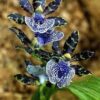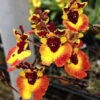# Caring for Dancing Lady Orchids (*Oncidium*) After Blooming

Dancing Lady Orchids, scientifically known as *Oncidium*, are admired for their stunning floral displays that resemble graceful dancers. These orchids produce an abundance of flowers that often bloom in vibrant colors and intricate patterns. However, once the blooming period ends, many orchid enthusiasts may wonder how to best care for their *Oncidium* plants to ensure they remain healthy and can thrive for future blooms. This comprehensive guide will cover essential care practices, troubleshooting tips, and advanced techniques for maintaining *Oncidium* orchids after they have finished flowering.
## 1. Understanding the Life Cycle of *Oncidium* Orchids
### 1.1 The Blooming Period
*Oncidium* orchids typically have a blooming period that lasts several weeks, during which they showcase their beautiful flowers. The timing of blooming can vary depending on the specific hybrid, environmental conditions, and care practices. After the flowers fade, the plant enters a post-bloom phase, requiring different care to promote continued growth and future blooms.
### 1.2 Transitioning After Blooming
Once the flowers have dropped, it is essential to transition your *Oncidium* orchid into a maintenance phase. During this time, the plant will focus on energy conservation, root development, and overall health. Proper post-bloom care is crucial for preparing the orchid for its next blooming cycle.
## 2. Assessing the Condition of Your Orchid
### 2.1 Inspecting the Plant
After blooming, begin by inspecting your *Oncidium* orchid thoroughly. Check for any signs of distress, such as:
– **Dried or Brown Flower Spikes**: Flower spikes will typically turn brown and shrivel after blooming. This is normal, and you can cut them back.
– **Leaves**: Healthy leaves should be firm and green. Look for any yellowing, wilting, or signs of pests.
– **Roots**: Examine the root system by gently removing the orchid from its pot. Healthy roots should be plump, firm, and green or white in color.
### 2.2 Identifying Potential Issues
During your inspection, take note of any issues that may require attention. Common problems include:
– **Pests**: Look for aphids, mealybugs, or spider mites, which can harm the orchid’s health.
– **Diseases**: Check for signs of fungal or bacterial infections, such as black spots or mushy areas on leaves or roots.
## 3. Pruning After Flowering
### 3.1 Cutting Back Flower Spikes
Once the flowers have fallen, it is essential to prune the flower spikes to encourage new growth. Follow these steps:
– **Locate the Right Spot**: If the spike is completely dried up, cut it back to the base, just above where it connects to the main stem. If the spike is still green, you can leave it to potentially produce new blooms later.
– **Use Clean Tools**: Always use sterilized scissors or pruning shears to prevent the spread of disease.
– **Make Clean Cuts**: Cut at a slight angle to encourage water runoff and reduce the risk of rot.
### 3.2 Trimming Yellow or Damaged Leaves
In addition to pruning flower spikes, check for any yellow or damaged leaves. Remove these to promote healthy growth:
– **Identify Affected Leaves**: Yellowing or damaged leaves can indicate a problem with care or health.
– **Prune at the Base**: Cut the leaf at its base using clean scissors, ensuring you do not damage the surrounding healthy foliage.
## 4. Watering Practices After Blooming
### 4.1 Adjusting Watering Frequency
After the blooming phase, adjust your watering schedule based on the orchid’s needs:
– **Watering Cycle**: Allow the potting medium to dry out slightly between waterings. Typically, this means watering every 7-10 days, but it can vary depending on environmental factors.
– **Check Moisture Levels**: Insert your finger into the potting medium to gauge moisture. If the top inch is dry, it’s time to water.
### 4.2 Watering Techniques
Use the following techniques to ensure proper watering:
– **Soaking Method**: Consider soaking the pot in water for about 15-20 minutes, allowing the roots to absorb moisture thoroughly. Drain excess water to prevent rot.
– **Avoid Overhead Watering**: When watering, focus on the potting medium rather than the leaves and flowers, as this can lead to fungal issues.
## 5. Light Requirements
### 5.1 Adjusting Light Exposure
After blooming, your *Oncidium* orchid may require different light conditions:
– **Bright, Indirect Light**: Maintain a location with bright, filtered light. Avoid direct sunlight, as it can scorch the leaves.
– **Monitor Growth**: If you notice leggy growth or pale leaves, your orchid may not be receiving enough light.
### 5.2 Seasonal Changes
As seasons change, be aware of adjustments in natural light:
– **Winter Care**: During shorter days, consider supplementing light with grow lights to maintain healthy growth.
– **Summer Care**: Ensure that your orchid is not exposed to intense afternoon sunlight, which can cause leaf burn.
## 6. Fertilization Practices
### 6.1 Resuming Fertilization
After blooming, reintroduce fertilization to promote healthy growth:
– **Type of Fertilizer**: Use a balanced orchid fertilizer, such as a 30-10-10 formulation, which is rich in nitrogen for leaf growth.
– **Dilution**: Dilute the fertilizer to half-strength to prevent burning the roots, especially after the stress of blooming.
### 6.2 Fertilization Schedule
Create a fertilization schedule:
– **Frequency**: Fertilize every 4-6 weeks during the growing season (spring and summer).
– **Watering After Fertilization**: Water the orchid thoroughly after fertilizing to help distribute nutrients and prevent salt buildup.
## 7. Humidity and Temperature
### 7.1 Maintaining Humidity Levels
*Oncidium* orchids thrive in humid environments, and maintaining appropriate humidity levels is crucial after blooming:
– **Ideal Humidity**: Aim for humidity levels between 50% and 70%.
– **Humidity Trays**: Use humidity trays filled with water and pebbles to increase humidity around the plant. Ensure that the pot does not sit directly in the water to avoid root rot.
### 7.2 Temperature Considerations
Monitor temperature to promote healthy growth:
– **Daytime Temperature**: Ideally, keep daytime temperatures between 75°F and 85°F (24°C to 29°C).
– **Nighttime Temperature**: Night temperatures should be cooler, around 60°F to 65°F (16°C to 18°C), to encourage blooming.
## 8. Repotting Considerations
### 8.1 When to Repot
Consider repotting your *Oncidium* orchid after it has finished blooming:
– **Signs That Repotting is Needed**: Look for crowded roots or if the potting medium has broken down and retained too much moisture.
– **Timing**: The best time to repot is during the growing season, typically in late spring or early summer.
### 8.2 Repotting Process
Follow these steps for successful repotting:
1. **Choose the Right Pot**: Select a pot that is 1-2 inches larger in diameter than the current pot.
2. **Prepare Fresh Medium**: Use a well-draining orchid potting mix, typically composed of bark, sphagnum moss, and perlite.
3. **Remove the Orchid**: Gently remove the orchid from its pot, loosening the roots if necessary.
4. **Clean the Roots**: Trim any dead or rotting roots with sterilized scissors before repotting.
5. **Position the Orchid**: Place the orchid in the new pot and fill with fresh medium, ensuring that the base of the plant is level with the top of the pot.
## 9. Addressing Common Problems
### 9.1 Pests and Diseases
After blooming, *Oncidium* orchids can still be susceptible to pests and diseases:
– **Common Pests**: Look for aphids, spider mites, and mealybugs. Treat infestations with insecticidal soap or neem oil.
– **Diseases**: Fungal and bacterial infections can occur. If you notice spots or mushy areas, remove affected parts and treat with appropriate fungicides.
### 9.2 Nutrient Deficiencies
Monitor your orchid for signs of nutrient deficiencies, such as yellowing leaves or stunted growth:
– **Yellow Leaves**: This may indicate a nitrogen deficiency, and a balanced fertilizer can help.
– **Dark Green Leaves**: If leaves are overly dark and lush, reduce fertilizer to avoid over-fertilization.
## 10. Encouraging Future Blooms
### 10.1 Preparing for Re-Blooming
To encourage your *Oncidium* orchid to bloom again:
– **Light Adjustment**: Gradually increase light exposure as the growing season approaches.
– **Temperature Variation**: Implement a slight drop in nighttime temperatures to mimic natural conditions, which can trigger blooming.
### 10.2 Patience is Key
Remember that *Oncidium* orchids can take time to bloom again after the post-bloom care phase. Be patient and continue to provide proper care, and soon you may be rewarded with a new display of beautiful flowers.
## 11. Conclusion
Caring for Dancing Lady Orchids (*Oncidium*) after they have finished blooming is essential for their overall health and ability to produce future blooms. By following the guidelines outlined in this article, you can ensure that your *Oncidium* orchids thrive during the
post-bloom phase. With proper watering, light, humidity, and pruning, these stunning orchids will continue to delight you with their beauty for years to come. Embrace the journey of orchid care and enjoy the unique charm of *Oncidium* in your home or garden.

